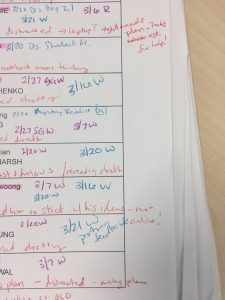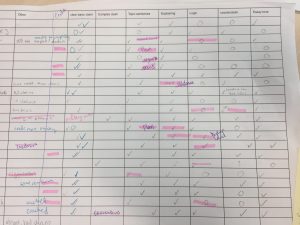Quickly Tracking Learning and Conferences
Conference notes, small group notes, tracking class habits and behaviors, recording students’ growth towards reaching standards and benchmarks… As teachers, we often struggle to find our own just right way to manage all these notes efficiently and effectively. Hopefully, we get a little better each year.

This year, I made another revision to my process that has made a huge impact: using one color to note the date I confer with a student until I see everyone, then I change to a new color.
Simple. But this little change makes it so much quicker for me to scan over a class and see who I need to confer with next.
Over the years, I have developed a pretty smooth combination of paper and digital notes. I use various paper systems depending on the purpose, but mostly I have a stack of class lists on a two column table and black small group record sheets. I print out a bunch so I can easily move to the next sheet in the moment when I’m ready.

I use the class lists mainly to record when I confer with students and if it was a reading or writing conference. This helps me quickly see who I need to meet with next, and what we might focus on, reading or writing. I also use this for anything I want to check in on the whole class quickly: titles of books, writing volume, stages of the writing process…
I use colors for my small group planning as well. One color for the planning: who, teaching point, and method of teaching. Then another color when I meet with them to add my notes.
 Recently, I noticed that one of my grade eight classes did not have the same strong community feel that my other class had. I used the same class list to record the students’ sports, activities, and service groups they were involved in. This helped me group students for English work who might already have a relationship from their afterschool activities. It also provided a quick cheat sheet for me to check in more casually with students as they came into class early.
Recently, I noticed that one of my grade eight classes did not have the same strong community feel that my other class had. I used the same class list to record the students’ sports, activities, and service groups they were involved in. This helped me group students for English work who might already have a relationship from their afterschool activities. It also provided a quick cheat sheet for me to check in more casually with students as they came into class early.
You can also see my sticky note here that I made before school: who I will see in a small group and conferences today.
 About once or twice in a unit, I will create a paper class checklist. Right now, I have one to help me record students’ speaking and listening skills in their book club conversations. Again, I use a different color each class and note the date in that color. I know these are little snapshots, so I am not looking for everything every time. I have a coding system I learned from a colleague many years ago: / is evidence and I add to it with each additional attempt. 0 means the student is struggling and I need to support them.
About once or twice in a unit, I will create a paper class checklist. Right now, I have one to help me record students’ speaking and listening skills in their book club conversations. Again, I use a different color each class and note the date in that color. I know these are little snapshots, so I am not looking for everything every time. I have a coding system I learned from a colleague many years ago: / is evidence and I add to it with each additional attempt. 0 means the student is struggling and I need to support them.
 In the previous unit, Literary Essay, I created a paper class checklist to help me quickly note what students were and were not yet doing in their essays (they wrote three). Then I pulled small groups to give feedback and teach. This is so much more efficient than writing up feedback for students. Also, by giving feedback in small groups, I get to teach them with a model and see right then as they try it if they are getting it or still need more support.
In the previous unit, Literary Essay, I created a paper class checklist to help me quickly note what students were and were not yet doing in their essays (they wrote three). Then I pulled small groups to give feedback and teach. This is so much more efficient than writing up feedback for students. Also, by giving feedback in small groups, I get to teach them with a model and see right then as they try it if they are getting it or still need more support.
In addition to these paper systems, I use Evernote to record the key information from one-on-one conferences. One of my colleagues taught me to use the voice to text feature and pointed out that she was more deliberate with the clarity of her teaching in conferences since she knew she would be saying the key points again in ear shot of the student. I have also noticed the power of students hearing the key points (compliment and teaching point) one more time. It also has helped build trust as they know what I am recording from our conversation.
I use one notebook per class, one note per student. I add the most recent note to the top with a quick date. One benefit is that I can do this on my phone (mostly), ipad, or laptop. Another benefit is that the EAL teacher who works with some of my students is shared on the notebook and adds her conference notes there too.
No matter what you try, it’s always good to pause and ask, “why?” What is the purpose for your notes? Are they helping you meet the needs of your students in this unit of work? Are they helping you balance your time across the class? Are they helping you synthesize students’ growth and areas to focus for reporting to parents? Some notes can be quick and messy. Some notes need more detail. Hopefully you can find a system that is efficient and effecitive.
Some notes can be quick and messy. Some notes need more detail. Hopefully you can find a just right system for you that is efficient and effective.